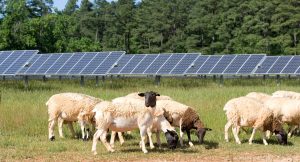 A few weeks ago, our team moved into SAS’ newest building, Building A. It’s a beauty, featuring a world-class training center, a bakery, and over 1000 pieces of artwork. While the abundance of baked goods is hard to beat, I think my favorite part about the building is the view. At 9 stories high, Building A is Cary’s tallest building, and it overlooks SAS’ solar farm and its accompanying herd of sheep. Yes, sheep.
A few weeks ago, our team moved into SAS’ newest building, Building A. It’s a beauty, featuring a world-class training center, a bakery, and over 1000 pieces of artwork. While the abundance of baked goods is hard to beat, I think my favorite part about the building is the view. At 9 stories high, Building A is Cary’s tallest building, and it overlooks SAS’ solar farm and its accompanying herd of sheep. Yes, sheep.
Sheep aren’t a typical fixture at most corporate campuses, so you probably have some questions. I had questions too, so I sat down with Millie Jones, SAS’ Sr. Manager of Landscaping, to get the scoop on all things sheep at SAS.
Millie shared that while the sheep are pretty cute, they’re more than eye candy – they’ve got an important job to do! Our herd munches the grass under and around the solar panels so the area is safely passable and easily accessible for regular maintenance. But, why sheep?
Let’s go back to the beginning.
When SAS was constructing its first solar farm, the project team hit a roadblock. They needed a way to maintain the land under the solar panels without disturbing the technology. Weekly mowing wasn’t going to cut it (no pun intended), and gravel would require the use of harsh chemicals to keep weeds at bay.
At SAS, our curiosity leads us to find unique and innovative solutions to problems, and the solar farm landscaping was no exception. The team did some digging and found that folks in Europe were using sheep to maintain land around solar panels. Millie owned some Dorper sheep at the time, so she brought them in for a test run – and the rest is history. Ten years later, a healthy herd of sheep call SAS’ solar farm their home.
Fun Facts
- All 36 sheep are female (#girlsquad), and some are SAS-lifers that were born on campus!
- They’re Dorper sheep, which is a breed of hair sheep. Originally from South Africa, hair sheep don’t require shearing. Instead, they craft their own ‘dos by rubbing up against fences and trees.
- They live on the solar farm, day and night. While they do have shelters available, Millie says they prefer to use the solar panels for shade and sleep under the stars at night.
- With names like “Buttercup,” “Miss Fleece,” and “Sassy,” it’s no surprise that the sheep were named by some of our most creative minds - the kiddos of SAS employees.
- They’re vegan! Our grazing gals munch on grass and clover, which is, according to Millie, surprisingly high in protein.
- The sheep are on the shy side and won’t usually approach people – “Unless you arrive in a white SAS landscaping pickup truck,” Millie adds. "They know they're getting a treat when a truck comes out!"
 Part of a bigger picture
Part of a bigger picture
As cool and unique as the sheep are, the herd is just a small part of a much bigger picture. Sustainability at SAS goes beyond recycling bottles and using compostable coffee cups - our efforts are interdependent, creating a self-functioning network of sorts. For example, Millie shared that clover makes up a large portion of the sheep’s diet. Our campus honey bees collect nectar from that same clover, allowing them to pollinate the beautiful flowers and plants around our campus. And our campus? It's powered in part by the green energy produced by our solar farms.
We’re committed to people and the planet, and our efforts show the world that successful business and earth friendliness aren’t mutually exclusive. Our founder and CEO, Dr. Jim Goodnight, says it best: “Our growth for more than 40 years proves that caring for our people, our planet, and our communities is the right way to do business.”
Curious about our commitment to sustainability? Give our latest Corporate Social Responsibility report to learn more.


1 Comment
Do we still have the donkeys?